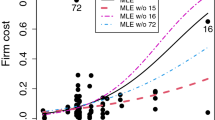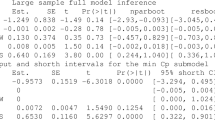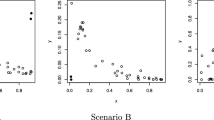Abstract
This paper addresses the issue of model selection in the beta regression model focused on small samples. The Akaike information criterion (AIC) is a model selection criterion widely used in practical applications. The AIC is an estimator of the expected log-likelihood value, and measures the discrepancy between the true model and the estimated model. In small samples, the AIC is biased and tends to select overparameterized models. To circumvent that problem, we propose two new selection criteria, namely: the bootstrapped likelihood quasi-CV and its 632QCV variant. We use Monte Carlo simulation to compare the finite sample performances of the two proposed criteria to those of the AIC and its variations that use the bootstrapped log-likelihood in the class of varying dispersion beta regressions. The numerical evidence shows that the proposed model selection criteria perform well in small samples. We also present and discuss and empirical application.
Similar content being viewed by others
Notes
For details on the BFGS algorithm, see Press et al. (1992).
The use of these criteria in beta regression models is done in an ad hoc manner.
References
Akaike H (1973) Information theory and an extension of the maximum likelihood principle. In: Petrov BN, Csaki F (eds) Proceedings of the second international symposium on information theory, pp 267–281
Allen D (1974) The relationship between variable selection and data augmentation and a method for prediction. Technometrics 16:125–127
Bayer FM, Cribari-Neto F (2015) Model selection criteria in beta regression with varying dispersion. Commun Stat Simul Comp. doi:10.1080/03610918.2014.977918
Bengtsson T, Cavanaugh J (2006) An improved Akaike information criterion for state-space model selection. Comput Stat Data Anal 50(10):2635–2654
Brehm J, Gates S (1993) Donut shops and speed traps: evaluating models of supervision on police behavior. Am J Polit Sci 37(2):555–581
Breiman L, Spector P (1992) Submodel selection and evaluation in regression: the X-random case. Int Stati Rev 60:291–319
Caby E (2000) Review: regression and time series model selection. Technometrics 42(2):214–216
Cavanaugh J (1997) Unifying the derivations for the Akaike and corrected Akaike information criteria. Statist Probab Lett 33(2):201–208
Cavanaugh JE, Shumway RH (1997) A bootstrap variant of AIC for state-space model selection. Stat Sin 7:473–496
Cribari-Neto F, Souza T (2012) Testing inference in variable dispersion beta regressions. J Statist Comput Simul 82(12)
Davies S, Neath A, Cavanaugh J (2005) Cross validation model selection criteria for linear regression based on the Kullback–Leibler discrepancy. Stat Methodol 2(4):249–266
Doornik J (2007) An object-oriented matrix language Ox 5. Timberlake Consultants Press, London. http://www.doornik.com/
Efron B (1979) Bootstrap methods: another look at the jackknife. Ann Stat 7(1):1–26
Efron B (1983) Estimating the error rate of a prediction rule: improvement on cross-validation. J Am Stat Assoc 78(382):316–331
Efron B (1986) How biased is the apparent error rate of a prediction rule? J Am Stat Assoc 81(393):461–470
Efron B, Tibshirani R (1997) Improvements on cross-validation: the 632+ bootstrap method. J Am Stat Assoc 92(438):548–560
Ferrari SLP, Cribari-Neto F (2004) Beta regression for modelling rates and proportions. J Appl Stat 31(7):799–815
Ferrari SLP, Pinheiro EC (2011) Improved likelihood inference in beta regression. J Stat Comput Simul 81(4):431–443
Frazer LN, Genz AS, Fletcher CH (2009) Toward parsimony in shoreline change prediction (i): basis function methods. J Coastal Res 25(2):366–379
Griffiths WE, Hill RC, Judge GG (1993) Learning and practicing econometrics. Wiley, New York
Hancox D, Hoskin CJ, Wilson RS (2010) Evening up the score: sexual selection favours both alternatives in the colour-polymorphic ornate rainbowfish. Anim Behav 80(5):845–851
Hannan EJ, Quinn BG (1979) The determination of the order of an autoregression. J Roy Stat Soc Ser B 41(2):190–195
Hjorth JSU (1994) Computer intensive statistical methods: validation, model selection and Bootstrap. Chapman and Hall
Hu B, Shao J (2008) Generalized linear model selection using \(\text{ R }^2\). J Stat Plan Inf 138(12):3705–3712
Hurvich CM, Tsai CL (1989) Regression and time series model selection in small samples. Biometrika 76(2):297–307
Ishiguro M, Sakamoto Y (1991) WIC: an estimation-free information criterion., Research memorandumInstitute of Statistical Mathematics, Tokyo
Ishiguro M, Sakamoto Y, Kitagawa G (1997) Bootstrapping log likelihood and EIC, an extension of AIC. Ann Inst Stat Math 49(3):411–434
Kieschnick R, McCullough BD (2003) Regression analysis of variates observed on (0, 1): percentages, proportions and fractions. Stat Modell 3(3):193–213
Koenker R, Yoon J (2009) Parametric links for binary choice models: a fisherian-bayesian colloquy. J Econ 152(2):120–130
Kullback S (1968) Information theory and statistics. Dover
Liang H, Zou G (2008) Improved aic selection strategy for survival analysis. Comput Stat Data Anal 52:2538–2548
McCullagh P, Nelder J (1989) Generalized linear models, 2nd edn. Chapman and Hall
McQuarrie A, Shumway R, Tsai CL (1997) The model selection criterion AICu. Statist Probab Lett 34(3):285–292
McQuarrie A, Tsai CL (1998) Regression and time series model selection. World Scientific, Singapure
McQuarrie A (1999) A small-sample correction for the Schwarz SIC model selection criterion. Statist Probab Lett 44(1):79–86
Nagelkerke NJD (1991) A note on a general definition of the coefficient of determination. Biometrika 78(3):691–692
Pan W (1999) Bootstrapping likelihood for model selection with small samples. J Comput Graph Stat 8(4):687–698
Paulino CDM, Pereira CAB (1994) On identifiability of parametric statistical models. J Ital Stat Soc 3(1):125–151
Press W, Teukolsky S, Vetterling W, Flannery B (1992) Numerical recipes in C: the art of scientific computing, 2nd edn. Cambridge University Press
R Core Team (2014) R: a language and environment for statistical computing. R Foundation for Statistical Computing, Vienna, Austria. http://www.R-project.org/
Rothenberg TJ (1971) Identification in parametric models. Econometrica 39(3):577–591
Schwarz G (1978) Estimating the dimension of a model. Ann Stat 6(2):461–464
Seghouane AK (2010) Asymptotic bootstrap corrections of AIC for linear regression models. Signal Process 90:217–224
Shang J, Cavanaugh J (2008) Bootstrap variants of the Akaike information criterion for mixed model selection. Comput Stat Data Anal 52(4):2004–2021
Shao J (1996) Bootstrap model selection. J Am Stat Assoc 91(434):655–665
Shi P, Tsai CL (2002) Regression model selection: a residual likelihood approach. J Roy Stat Soc Ser B 64(2):237–252
Shibata R (1997) Bootstrap estimate of Kullback–Leibler information for model selection. Stat Sin 7:375–394
Simas AB, Barreto-Souza W, Rocha AV (2010) Improved estimators for a general class of beta regression models. Comput Stat Data Anal 54(2):348–366
Smithson M, Verkuilen J (2006) A better lemon squeezer? Maximum-likelihood regression with beta-distributed dependent variables. Psychol Methods 11(1):54–71
Sugiura N (1978) Further analysts of the data by Akaike’s information criterion and the finite corrections—further analysts of the data by Akaike’s. Commun Stat Theor M 7(1):13–26
Verhaelen K, Bouwknegt M, Carratalà A, Lodder-Verschoor F, Diez-Valcarce M, Rodríguez-Lázaro D, de Roda Husman AM, Rutjes SA (2013) Virus transfer proportions between gloved fingertips, soft berries, and lettuce, and associated health risks. Int J Food Microbiol 166(3):419–425
Whiteman A, Young DE, He X, Chen TC, Wagenaar RC, Stern C, Schon K (2014) Interaction between serum BDNF and aerobic fitness predicts recognition memory in healthy young adults. Behav Brain Res 259(1):302–312
Winkelmann R (2008) Econometric analysis of count data, 5th edn. Springer, p 320
Zucco C (2008) The president’s “new” constituency: Lula and the pragmatic vote in Brazil’s 2006 presidential elections. J Lat Am Stud 40(1):29–49
Acknowledgments
We gratefully acknowledge partial financial support from CAPES, CNPq, and FAPERGS. We also thank two referees for comments and suggestions.
Author information
Authors and Affiliations
Corresponding author
Appendix A: score function and information matrix of the beta regression model with varying dispersion
Appendix A: score function and information matrix of the beta regression model with varying dispersion
This appendix presents the score function and Fisher’s information matrix for the varying dispersion beta regression model described in Sect. 3.
The score function is obtained by differentiating the log-likelihood function with respect to the unknown parameters. The score function of \(\log f(Y|\theta _{k})\) with respect to \({\beta }\) is given by
where \(\Phi \!= \!\text {diag}\! \left\{ \frac{1\!-\! \sigma ^2_1}{\sigma ^2_1},\ldots ,\frac{1\!-\sigma ^2_n}{\sigma ^2_n} \right\} \), \(T \!=\! \text {diag}\left\{ \frac{1}{g^{\prime }(\mu _1)},\ldots ,\frac{1}{g^{\prime }(\mu _n)}\right\} \), \({y}^{*}\!=\!(y^{*}_1,\ldots ,y^{*}_n)^{\top }\), \({\mu }^{*}\!=\!(\mu ^{*}_1,\ldots ,\mu ^{*}_n)^{\top }\), \(y^{*}_t \! = \log \left( \frac{y_t}{1-y_t} \right) \), \(\mu ^{*}_t= \psi \left( \mu _t\left( \frac{1-\sigma ^2_t}{\sigma ^2_t}\right) \right) - \psi \left( (1-\mu _t)\left( \frac{1-\sigma ^2_t}{\sigma ^2_t}\right) \right) \) and \(\psi (\cdot )\) is the digamma function, i.e., \(\psi (u)\!=\frac{\partial \log \Gamma (u)}{\partial u}\), for \(u>0\). The score function of \(\log f(Y|\theta _{k})\) with respect to \({\gamma }\) is
where \(H\! = \!\text {diag} \!\left\{ \! \frac{1}{h^{\prime }(\sigma _1)}, \ldots , \frac{1}{h^{\prime }(\sigma _n)} \!\right\} \) and \({a}= ( a_1,\) \( \ldots ,a_n)^{\top }\), the \(t\)th element of \(a\) being \(a_t = -\frac{2}{\sigma ^3_t} \left\{ \mu _t \left( y^*_t - \mu ^*_t \right) + \log (1-y_t) - \psi \left( (1-\mu _t)(1-\sigma ^2_t)/\sigma ^2_t \right) + \psi \right. \left. \left( (1-\sigma ^2_t) / \sigma ^2_t \right) \right\} \).
Fisher’s information matrix for \({\beta }\) and \({\gamma }\) is given by
where \(K_{({\beta },{\beta })} = X^{\top }\Phi WX \), \(K_{({\beta },{\gamma })} = (K_{({\gamma },{\beta })})^{\top }=X^{\top }CTHZ\) and \(K_{({\gamma },{\gamma })}=Z^{\top }DZ\). Also, we have \(W = \text {diag}\{w_1,\ldots ,w_n\}\), \(C = \text {diag}\{c_1,\ldots ,c_n\}\) and \(D = \text {diag}\{d_1,\ldots ,d_n\}\), where
Rights and permissions
About this article
Cite this article
Bayer, F.M., Cribari-Neto, F. Bootstrap-based model selection criteria for beta regressions. TEST 24, 776–795 (2015). https://doi.org/10.1007/s11749-015-0434-6
Received:
Accepted:
Published:
Issue Date:
DOI: https://doi.org/10.1007/s11749-015-0434-6




